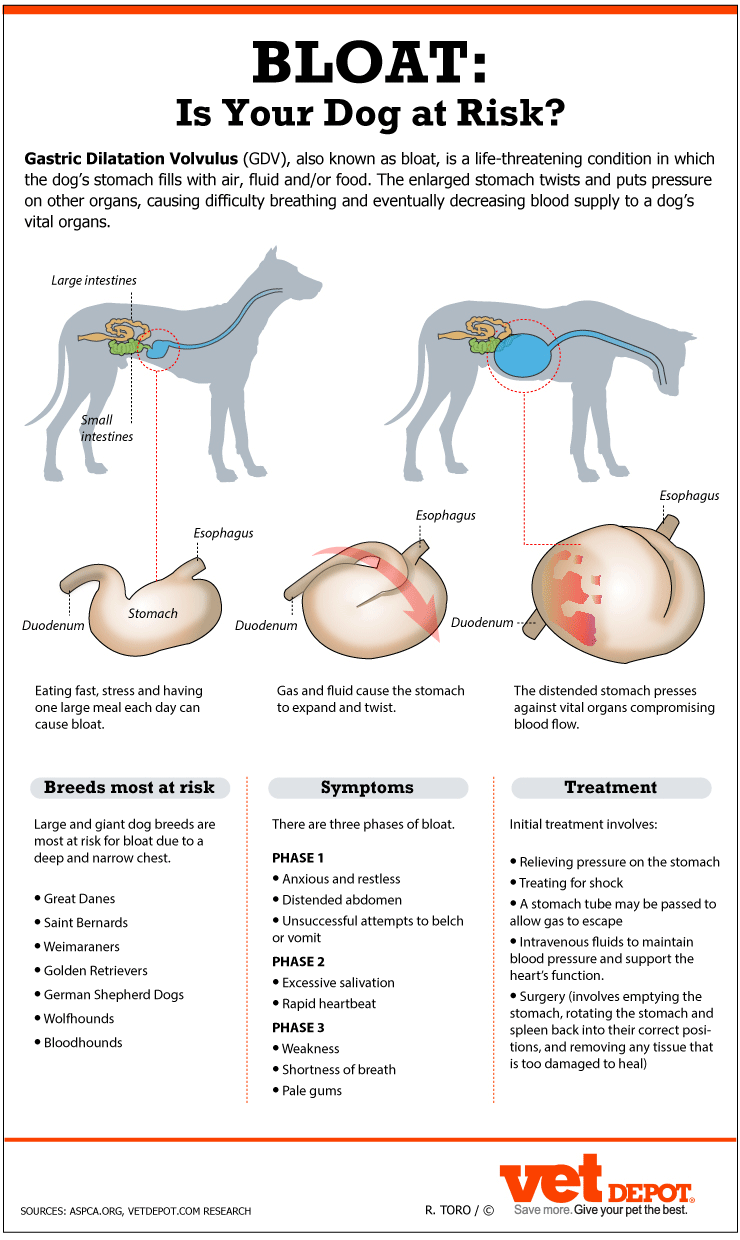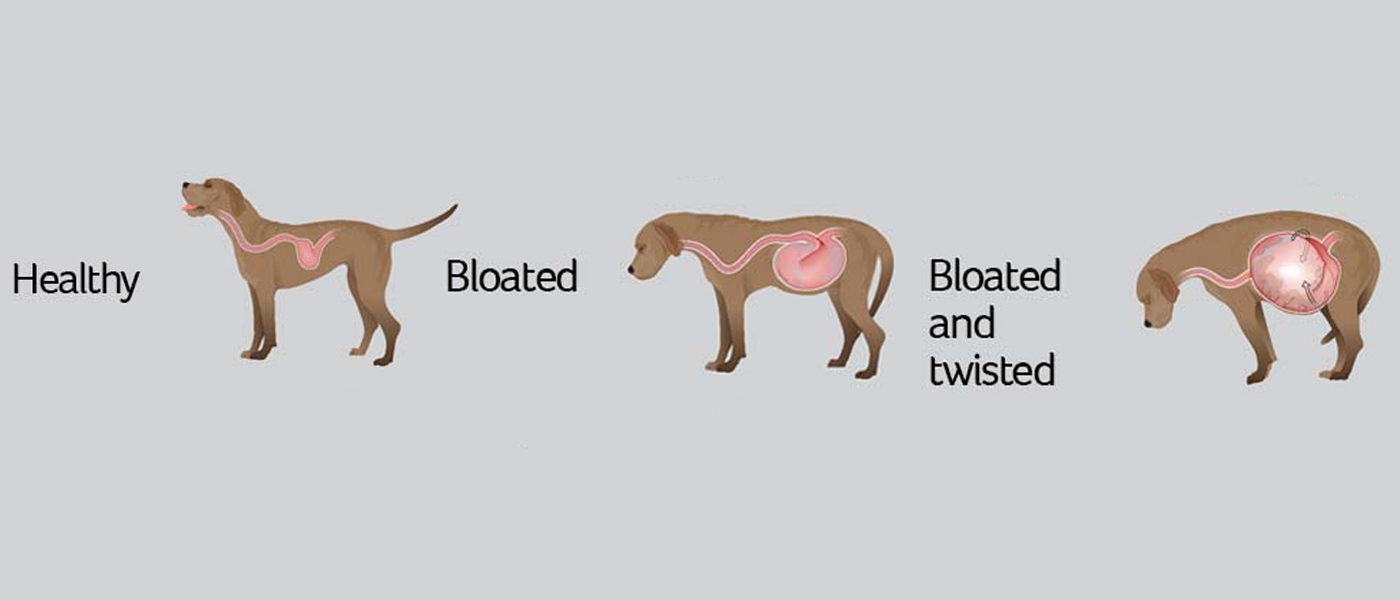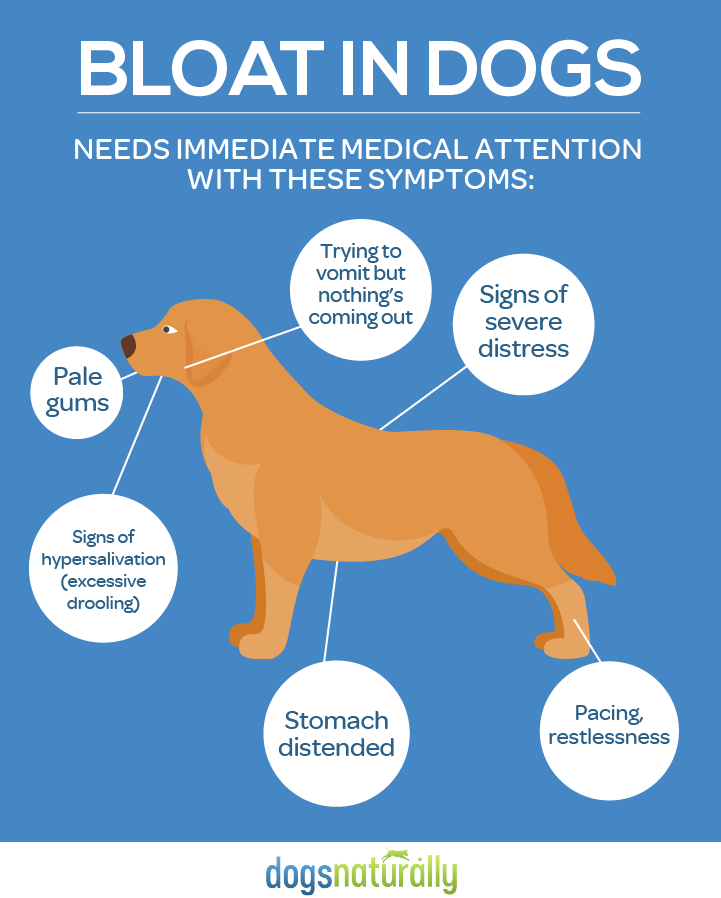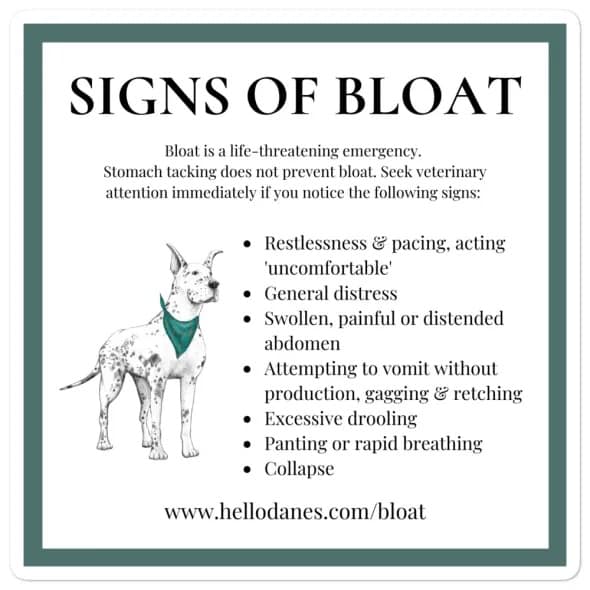
Bloat Is Your Dog at Risk?
Symptoms of Bloat in Dogs. Bloat is a very uncomfortable, often painful, health crisis for dogs. As a result, a dog with bloat may: Dry-heave (also called retching) without vomiting any food. Sometimes a dog might spit out white foam when trying to vomit, which is usually mucus from the esophagus or stomach.

What Happens When Dogs Get Bloat
Take the dog to the vet as quickly as possible. Death is imminent. Get someone to tell your vet you are your way and why. Take the dog to the vet as quickly as possible. During this period the dog may recover without going on to develop Gastric Volvulus. During this period the dog may recover if your vet releases the pressure with a stomach tube.

GDV bloat Vetlife Animal Health Partners
Pacing Restlessness/Anxiousness Crying and/or whining Inability or unwillingness to settle or lie down Increased heart rate Pale mucus membranes (the tissue around their teeth) The appearance of a wide stance with elbows extended Not all dogs with GDV will exhibit all of these signs and symptoms.

How Is Bloat Caused In Dogs
Bloat in dogs becomes life-threatening when it becomes gastric dilation-volvulus (GDV). Bloat GDV happens when a dog's stomach has rotated or twisted. The gastric dilation pushes on large arteries and veins in the area, and this impacts the blood supply the stomach needs.

Bloat in Dogs What it is, How to Spot it, and What to do When You See it. Atlanta Rescue Dog Cafe
In dogs, bloating can be a very catastrophic condition that has a rapidly progressing timeline. Bloat or GDV happens when food, fluid, or air causes the dog's stomach to expand. As the stomach gets larger, it can prevent the release of stomach contents or gases.

all dog owners should know... — Symptoms of bloat include hard, swollen abdomen...
large breeds large dogs bloat If you believe your dog is suffering from symptoms of bloat, call your vet or emergency vet immediately. I hate this disease. When I first started as a vet, we.

What Causes Bloat In Large Dogs
What causes the condition? The exact cause of GDV is still unknown. The condition is seen more commonly in large, deep-chested male dogs. Exercise after ingestion of large meals or large amounts of water may increase risk. "Stress may be a contributing factor to GDV."

BLOAT Could Your Dog Be at HighRisk for this LifeThreatening Condition?
Life stage: All Bloat is a condition when a dog's stomach gets over distended (swollen) with food and/or gas. The condition becomes particularly dangerous when a dog's stomach turns on itself, known as GDV. Large breed dogs and dogs with deep chests are more susceptible to bloat.

Bloat in Dogs (Gastric Torsion) Causes, Symptoms & Treatments
Here are a few key facts about bloat: Bloat should always be treated as a medical emergency. Bloat can kill a dog within hours after onset. The cause of bloat is unknown. Bloat affects 36,000 dogs in the United States each year; 30% die as a result of this condition. Bloat can occur in dogs of any age. Certain breeds are more susceptible to.

Bloat in dogs causes, symptoms and prevention
Dog bloat is caused by stomach distension — The first signs include restlessness and a visibly distended stomach. Dog bloat can be lethal — Acute dog bloat can cause the stomach to rotate and is life-threatening. Early treatment of dog bloat could save your dog's life — The moment you notice symptoms, you should head to the vet.

What To Do When Your Dog Is Bloated Medical Help for Dogs
Bloat, also known as Gastric Dilatation and Volvulus (GDV), is a serious condition in which a dog's stomach fills and the abdomen becomes painfully dilated. Keep reading to learn about symptoms, treatments, and more. Anne-Marie Kennedy Digital Writer Posted August 16, 2023

Great Dane Bloat 9 Crucial Things You Need to Know Hello Danes
Commonly referred to as "bloat," GDV occurs when a dog's stomach fills with gas, food, or fluid and subsequently twists. GDV develops without warning and can progress quickly. It is always an emergency. Stomach distension alone is referred to as a "simple bloat", or dilatation. This simple bloating can occur on its own and may resolve on.
:max_bytes(150000):strip_icc()/SPR_2804919-bloated-puppy-5afca0703418c60038284343.png)
Taking Care of Bloated Puppies
published 25 May 2022 GDV in dogs, especially large and giant breeds is a common condition - knowing the symptoms could save your dog's life (Image credit: Getty Images) Gastric dilation and volvulus, more commonly known as GDV or bloat, is one of the most serious medical emergencies veterinarians encounter in dogs.

8 People In Your Dog's Life That Should Have a Bloat Chart My Brown Newfies
Gastric dilatation-volvulus, or "bloat" for short, is a feared disease among many dog owners. I have worked as an emergency veterinarian and have observed first-hand the horrible effects of this condition on a number of my patients, and I can certainly attest to its devastating effects.

Bloat in Dogs What are the Symptoms, Treatment, and Prevention
Bloat occurs when the stomach becomes over-distended with gas or food. This can lead to the stomach twisting around on itself - a condition called gastric dilatation-volvulus or GDV. This is a rapidly progressive life threatening condition which requires emergency stabilization and surgery to correct. Most commonly, GDV affects large deep chested dogs such as…

Bloat in Dogs
What are the signs of bloat in dogs? Just like my veterinary client described, symptoms of bloat can be pretty dramatic: Significant abdominal distention (Hence the term "bloat.") Retching—since the entrance to the stomach is "blocked" by the twisting, the dog can't bring anything up when trying to vomit. Restlessness Panting Drooling